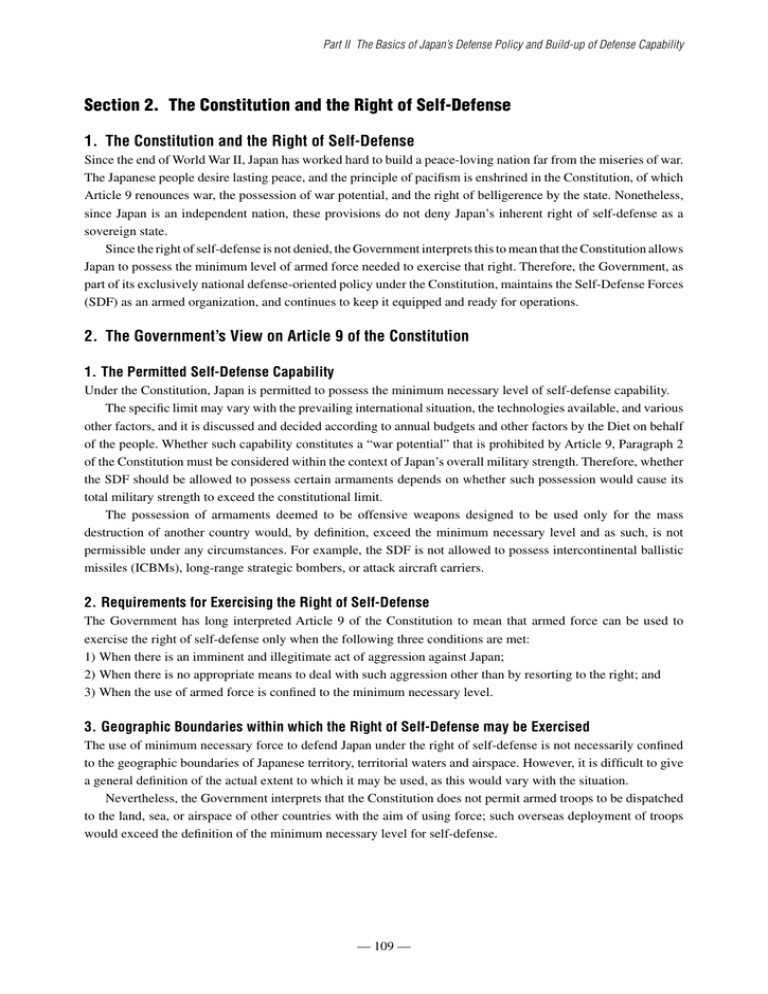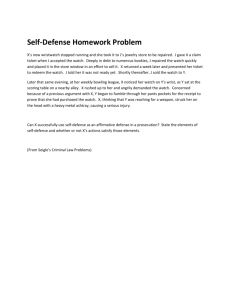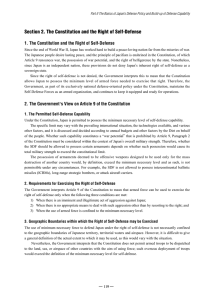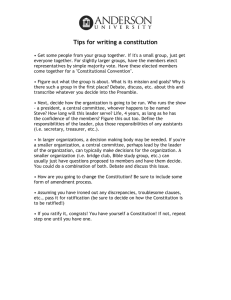Section 2. The Constitution and the Right of Self-Defense
advertisement

Part II The Basics of Japan’s Defense Policy and Build-up of Defense Capability Section 2. The Constitution and the Right of Self-Defense 1. The Constitution and the Right of Self-Defense Since the end of World War II, Japan has worked hard to build a peace-loving nation far from the miseries of war. The Japanese people desire lasting peace, and the principle of pacifism is enshrined in the Constitution, of which Article 9 renounces war, the possession of war potential, and the right of belligerence by the state. Nonetheless, since Japan is an independent nation, these provisions do not deny Japan’s inherent right of self-defense as a sovereign state. Since the right of self-defense is not denied, the Government interprets this to mean that the Constitution allows Japan to possess the minimum level of armed force needed to exercise that right. Therefore, the Government, as part of its exclusively national defense-oriented policy under the Constitution, maintains the Self-Defense Forces (SDF) as an armed organization, and continues to keep it equipped and ready for operations. 2. The Government’s View on Article 9 of the Constitution 1.The Permitted Self-Defense Capability Under the Constitution, Japan is permitted to possess the minimum necessary level of self-defense capability. The specific limit may vary with the prevailing international situation, the technologies available, and various other factors, and it is discussed and decided according to annual budgets and other factors by the Diet on behalf of the people. Whether such capability constitutes a “war potential” that is prohibited by Article 9, Paragraph 2 of the Constitution must be considered within the context of Japan’s overall military strength. Therefore, whether the SDF should be allowed to possess certain armaments depends on whether such possession would cause its total military strength to exceed the constitutional limit. The possession of armaments deemed to be offensive weapons designed to be used only for the mass destruction of another country would, by definition, exceed the minimum necessary level and as such, is not permissible under any circumstances. For example, the SDF is not allowed to possess intercontinental ballistic missiles (ICBMs), long-range strategic bombers, or attack aircraft carriers. 2.Requirements for Exercising the Right of Self-Defense The Government has long interpreted Article 9 of the Constitution to mean that armed force can be used to exercise the right of self-defense only when the following three conditions are met: 1)When there is an imminent and illegitimate act of aggression against Japan; 2)When there is no appropriate means to deal with such aggression other than by resorting to the right; and 3)When the use of armed force is confined to the minimum necessary level. 3.Geographic Boundaries within which the Right of Self-Defense may be Exercised The use of minimum necessary force to defend Japan under the right of self-defense is not necessarily confined to the geographic boundaries of Japanese territory, territorial waters and airspace. However, it is difficult to give a general definition of the actual extent to which it may be used, as this would vary with the situation. Nevertheless, the Government interprets that the Constitution does not permit armed troops to be dispatched to the land, sea, or airspace of other countries with the aim of using force; such overseas deployment of troops would exceed the definition of the minimum necessary level for self-defense. — 109 — 4.The Right of Collective Self-Defense International law permits a state to have the right of collective self-defense, which is the right to use force to stop an armed attack on a foreign country with which the state has close relations, even if the state itself is not under direct attack. Since Japan is a sovereign state, it naturally has the right of collective self-defense under international law. Nevertheless, the Japanese Government believes that the exercise of the right of collective selfdefense exceeds the limit on self-defense authorized under Article 9 of the Constitution and is not permissible. 5.The Right of Belligerence Article 9, Paragraph 2 of the Constitution prescribes that the “the right of belligerence of the State shall not be recognized.” However, the “right of belligerence” does not mean the right to engage in battle; rather it is a general term for various rights that a belligerent nation has under international law, including the authority to inflict casualties and damage upon the enemy’s military force and to occupy enemy territory. On the other hand, Japan may of course use the minimum level of force necessary to defend itself. For example, if Japan inflicts casualties and damage upon the enemy’s military force in exercising its right of selfdefense, this is conceptually distinguished from the exercise of the right of belligerence, even though the actual actions appear to be no different. Occupation of enemy territory, however, would exceed the minimum necessary level of self-defense and so is not permissible. (See Column) [COLUMN] COMMENTARY Discussions Involving the Constitution The Law concerning the Procedure to Revise the Constitution of Japan (the national referendum law) was enacted in May 2007 to be substantially enforced in 2010. This law provides the basis of a national referendum for the approval of the Japanese people concerning the revision of the Constitution. In addition, as a partial enforcement of the law, a research commission on the Constitution was installed in both houses in August last year. Recent years have seen discussions on the Constitution in the Diet and other venues. The commissions on the Constitution of both houses submitted reports in April 2005. The reports referred to security issues, such as Article 9 of the Constitution, the right of self-defense and the Self-Defense Forces, as well as international cooperation. The reports introduce the various opinions that were discussed in these commissions. Subsequently, the Democratic Party of Japan announced its proposals on the Constitution in October 2005, while the Liberal Democratic Party presented its draft for a new Constitution in the following month. The New Komeito Party advocates that the Constitution should be reinforced by additional concepts. Article 9 of the Constitution is one of the issues raised by parties. These parties clarified their policy to uphold pacifist principles, and the Liberal Democratic Party drafted articles of the “self-defense military forces” and its activities. In addition, the Democratic Party of Japan and the New Komeito Party have also shown their perspective and points about the existence of the Self-Defense Forces and the positioning of its international activities. — 110 —






